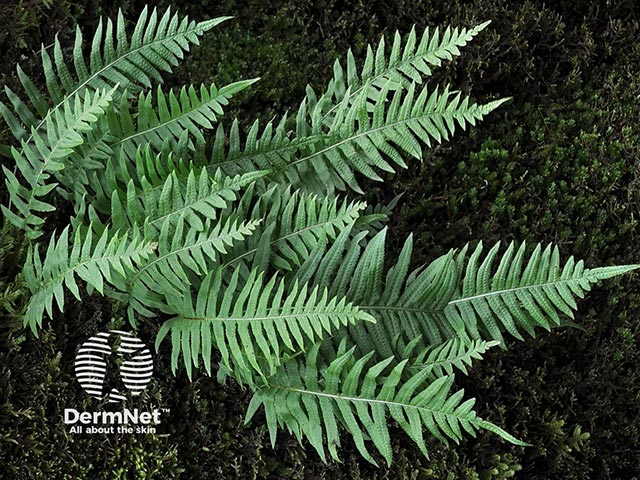Main menu
Common skin conditions

NEWS
Join DermNet PRO
Read more
Quick links
Last reviewed: December 2023
Author: Dr Ian Coulson, Consultant Dermatologist and DermNet Editor-in-Chief, United Kingdom (2023)
Previous author: Vanessa Ngan, Staff Writer (2005)
Introduction
How it works
Uses
How to use
Precautions
Side effects
Polypodium leucotomos extract (PLE) comes from a tropical fern plant grown in Central and South America. Native Americans have used the plant extract for centuries for the treatment of inflammatory disorders and skin diseases where the plant is known as “calaguala” and the extract “anapos”. Clinical research has shown that it has antioxidant and photoprotective properties and when taken orally and used topically, it provides protection against the harmful effects of ultraviolet (UV) radiation from the sun and other sources.
The extract contains phenolic compounds including cinnamates, and a number of acidic molecules (quinic, shikimic, glucuronic and malic acids). These phenols have strong antioxidant actions.

The polypodium leucotomos fern in its natural habitat
To gain a better understanding of how polypodium leucotomos extract works, you need to understand the effects of UV radiation on the body. These are described in the article on sunburn.
The proposed mechanism of action of oral polypodium leucotomos extract is fairly complex but has been summarised into the following main points:
Oral ingestion of 480 mg reduces sunburn redness at 24 hours after exposure, and biopsy specimens show less sunburn cells. Topical application of extract, immediately prior to UVB exposure, reduced the number of sunburn cells, p53, p21, and ki-67 cells in the epidermis, confirming the photoprotective effect of the extract.
So far, only indirect evidence has accrued and long placebo-controlled studies will be needed to show significant reductions in non-melanoma and melanoma skin cancer incidence.
An uncontrolled study of both topical and oral PLE in 18 Moroccan patients with xeroderma pigmentosum showed that only 7 of 18 treated patients developed new skin cancer in a 12 month period.
PLE should be used as an adjunct to the armamentarium against the damaging effects of UV radiation exposure. It should be considered as another layer of protection and used in conjunction with a good sunscreens and protective clothing.
Higher doses (up to 960 mg a day) reduced the severity of polymorphic light eruption or increased the number of exposures of UV required to elicit PLE reactions.
Small numbers have been studied, but reduction in severity in solar urticaria was noted.
Most studies for vitiligo have used a combination of oral PLE and either narrowband UVB or PUVA, and have show a better degree of repigmentation than using phototherapy alone.
A study of 21 patients with epidermal melasma received 240 mg of PLE or placebo, and an SPF 45 sunscreen for 12 weeks. Almost 50% noted benefit from the active combination, none were helped by the placebo. A study combining oral oral PLE (480 mg daily) with sunscreen and 4% hydroquinone showed an additional benefit from the combination.
PLE can also be used to protect against photochemotherapy (PUVA)-induced skin phototoxicity. Extensive PUVA treatment results in premature ageing changes in the skin (increased dryness, freckling and wrinkling) and can increase the chance of skin cancer. Fair-skinned individuals or those with previous sun or radiation damage are most at risk. In clinical trials, PLE has proven to be the first oral agent effective in reducing the harmful side effects of PUVA treatment.
PLE is marketed as a dietary supplement containing a combination of the antioxidants (Heliocare®, Antioxidine®, Fernblock®, and others). These are rapidly absorbed and provide early protection that lasts up to 2 hours after administration, against the initial signs of sunburn (erythema). However, the photoprotective effect of polypodium leucotomos extract extends beyond just decreasing erythema. The antioxidant properties of orally administered PLE work at protecting the skin at a deeper cellular level that is not achieved with topically applied antioxidants.
PLE has not been clinically tested in patients less than 18 years and in pregnant or breastfeeding women. Hence there is no data to support its use in these groups.
Oral PLE supplements have been used in Europe since the 1980s without any side effects being reported.
Polypodium leucotomos extract has not been thoroughly tested for interactions with other supplements and drugs. Some concern has been expressed that it may interact with medications that affect the function of the heart or blood pressure, as cardiac effects have been demonstrated with a related fern species, Polypodium vulgare.